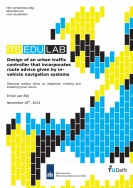Increased mobility has caused a constant increase in the amount of traffic since the introduction of the first cars in the 19th century. This increase caused several negative effects, such as congestion or emissions of air pollutants and greenhouse gasses. One way of reducing these negative effects is making more efficient use of the existing infrastructure. Intelligent Transport Systems (ITS) are a means to do this. Integrated use of different kinds of ITS could increase the effectiveness of all components of the integrated system. In 15 years all road-users are expected to be connected through the use of smart phones or navigation devices. In this thesis the possibilities are studied to make use of this connectivity and integrate the system of connected vehicles with an Urban Traffic Controller (UTC).
The problem of optimizing the control of an urban traffic network, consisting of multiple links and traffic lights, in real time, has been formulated many years ago. However, the problem is too large and complex to be solved online for traffic networks consisting of more than just a few intersections. Therefore, current traffic control systems have incorporated simplifications in order to reduce computation times. Centralized systems, that solve the control problem for multiple intersections at once, have been found to use lots of historic data and only solve part of the problem online. On the other hand, systems that solve the traffic control problem for just one intersection are able to optimize control, based on the current traffic situation at the intersection. However, these controllers neglect the fact that a traffic network is an interconnected system and what might be the best solution for one intersection, might be a bad decision for the entire traffic network. Information from a VRGS could improve the functioning of either UTC.
From the possible applications of an integrated system, one application has been chosen to be developed into an UTC. This application is the use of the predicted route demands in an urban traffic network to choose between coordinating traffic lights, in order to create a green wave, and controlling intersections with local (vehicle-actuated) controllers. The route demands will be generated from the information sent by VRGS on the locations, intended routes and destinations of vehicles. The controller is supposed to choose the strategy that generates the lowest lost times, given the predicted demands. A simulation study, consisting of 3 separate case studies, is performed to test the controller. In the first case study the parameters of the controller were identified to meet the characteristics of the test network. In a second test case, the method, used to predict the lost times in the network, has been calibrated. In the third and final case study, the controller is compared to vehicle-actuated control and coordinated control, used separately. The controller proved to have the potential to decrease travel times by using the proper control approach for each traffic situation. Compared to VA-control, the switching approach decreased lost times up to 14%.
